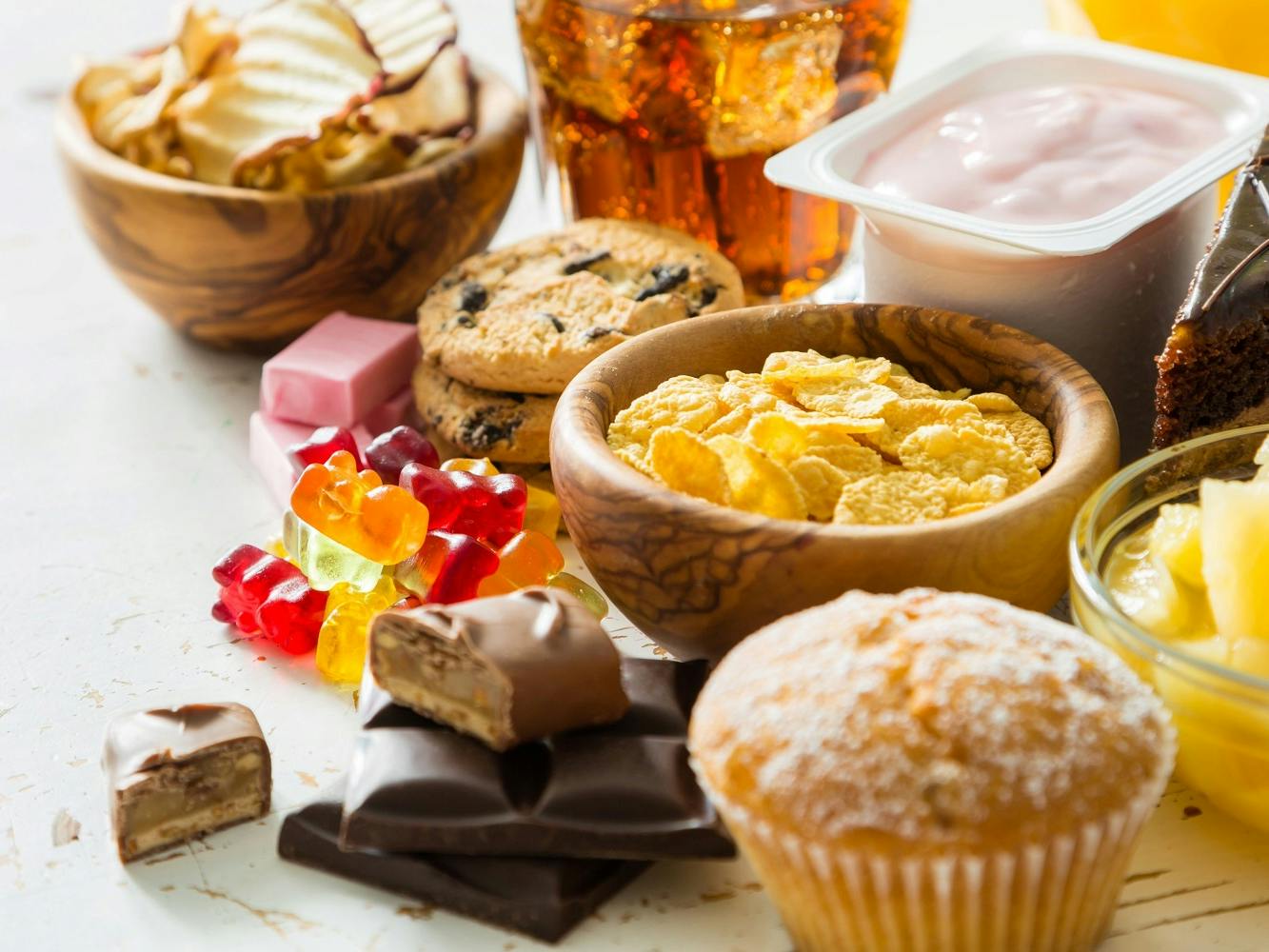
Sugar is the body’s main source of fuel, but too much of a good thing can be unhealthy.
Sugar is an essential part of our diets. Everyone needs sugar to survive, as it’s the main source of energy for every cell in the body, including the brain. Among humans, a liking for sugar is universal – in fact, babies are born with an innate taste for sweetness. So why should we be concerned with reducing how much sugar we consume?
For one thing, most of us eat far more than our bodies need for fuel. It’s estimated that the average American consumes around 70 grams of sugar (about 17 teaspoons) or more a day, though health organizations like the American Heart Association recommend no more than 24 grams for women and 36 for men.
Too much sugar – or the wrong kind – can lead to a higher risk of weight gain, high blood pressure, diabetes, and other health conditions. Everyone should be aware of how much and what kinds of sugar they’re consuming. People with diabetes should pay even closer attention and monitor their intake more strictly.
What is sugar?
When most of us say "sugar," we’re referring to the sweet stuff spooned into coffee or tea or used in cookie dough. In fact, sugar refers to many sweet-tasting carbs that are often contained in or added to foods. The chemical names for these various sugars end in "ose." Fructose, for example, is the natural sugar contained in fruits. Lactose is the sugar in milk and other dairy products. Refined white table sugar, which is often added to processed foods, is sucrose.
There are also foods that don’t taste sweet at all that contain sugar. These are carbs that the body converts to sugar (glucose). If you eat a bowl of rice, a potato, or a slice of bread, you’re eating sugar.
Complex versus simple carbs
Even though we need sugar for energy, some foods provide this energy better than others.
When people eat complex carbs--whole plant foods like fruits and grains, which contain fiber in addition to sugar--the sugar is digested slowly along with the other nutrients, providing the body with a steady source of energy.
But when sugar is added to foods—like sweet desserts that contain white flour, sugar, or other simple carbohydrates—it’s digested very quickly, causing the level of sugar in the blood to rise quickly. This leads to energy spikes and quick crashes.
You don’t want to have a diet full of sweets and desserts, but you do want to have whole grain bread, whole wheat pasta, brown rice, and fruit. You need these healthy carbs to help fuel your body.
Natural versus added sugar
Dietitians distinguish between "natural" and "added" sugar. Natural sugar occurs naturally in a food. A banana, for example, is sweet because it contains natural sugar. Foods containing natural sugar can be nutritious and beneficial. Most also contain vitamins, minerals, antioxidants, and fiber.
Other foods, including many processed foods, have sugar added to them, mainly for taste. This is the sugar that health experts urge people to limit. The body has more trouble handling this kind of extra sugar, and it provides little to no nutritional value. In fact, excess added sugar has been linked to no fewer than 45 negative health effects.
"Added sugar intake can promote inflammation in the body, and this can cause stress on the heart and blood vessels, which can lead to increased blood pressure," said Brooke Aggarwal, assistant professor of medical sciences in the cardiology division at Columbia University Irving Medical Center, in an interview with CNN. Consuming too much added sugar is also a risk factor for other chronic health conditions such as diabetes and some cancers.
A word of caution when reading food labels: The term "natural" can be misleading. Just because sugar comes from a beet, or a cane plant, or a bee, or a maple tree, doesn’t make it natural. Cane sugar that’s been taken from a cane plant and added to another food is an added sugar.
Sugar by any other name
Food manufacturers have lots of ways to hide the sugar in the list of ingredients. Here are just a few of the aliases sugar may use:
- Words ending in "ose" (dextrose, fructose, maltose, etc.)
- Words ending in "ol" (sorbitol, xylitol, mannitol)
- Syrups (maple syrup, agave syrup, cane syrup, corn syrup, golden syrup, malt syrup, maple syrup, rice syrup, etc.)
- Honey
- Molasses
- Cane juice crystals or evaporated cane juice
- Fruit juice
- Barley malt
- Dextrin
- Maltodextrin
- Sucanat
And many, many more! That’s why it’s smart to check the nutrition label for total grams of added sugar.
Understand the marketing jargon
You might be thinking, "Who wants to read the label? Can’t I just buy the package labeled "less sugar"? You can, but be sure to know what the different labels mean.
"Less sugar," "lower sugar," "low in sugar," or "reduced sugar" on a label simply means there’s 25 percent less than in the original version of the product. So if the original product had a lot of added sugar, the reduced sugar version could still have quite a bit.
"Sugar-free" sounds straightforward, but be careful. This label means that a serving has to contain less than half a gram of sugar. If a serving is two cookies but you eat half a sleeve of them – hey, we’ve all been there – you could still wind up consuming a lot of added sugar.
"No sugar added" or "no added sugar" means that no sugar or sugar-containing ingredient has been added during food processing. There may be sugar naturally contained in the food, such as in fruits.
Ways to eat less sugar
Cut back on obvious culprits
Giving up favorite foods is hard, but you don’t have to give up your morning muffin altogether. See if there’s a reduced sugar version. Split it with a coworker and add a banana to the mix. Alternate between oatmeal and your muffin for breakfast each day. Little changes can add up over time.
Can I Eat Ice Cream and Still Be Healthy?
Cook from scratch more often
When you cook from scratch, you control the added sugar. If you’re following a pie recipe that calls for a half-cup of sugar, see how it tastes with only one-third cup. You may not notice the difference!
Make your own condiments
You can use oil and vinegar instead of bottled salad dressing. Or make your own barbecue sauce with more spices—paprika, onion, garlic—and less sugar.
Sweeten with fruit
Plain oatmeal or yogurt may sound unappealing, but adding real fruit kicks it up a notch. And since real fruit takes longer to digest than simple sugar, your oatmeal or yogurt will keep you satisfied longer.
Learn 6 Ways to Get More Fruit in Your Diet
Snack Smart
A lot of foods high in added sugars are eaten as snacks or desserts. Try to make fruit the main ingredient of your snacks and desserts instead. Add another source of fiber or some protein to help slow digestion and prevent spikes in blood sugar. Examples of healthy snacks include berries with some nuts, a banana with natural peanut butter, or grapes with a slice of low-fat cheese.
Are You Getting Enough Protein?
Sugar, health, and Medicare
Too much added sugar can mean added health problems. Original Medicare can help with covered annual wellness checks to review your health markers, as well as coverage for treatments for high blood pressure and diabetes. Many Medicare Advantage plans go further, covering dental treatment and consultations with a nutritionist. Check out our Find a Plan tool to find the best policy in your area.
Additional resources
- ClearMatch Medicare: Find a Medicare Plan
- CNN: Health Effects of Added Free Sugars Study
- CNN: Link Between Free Sugar Intake and Cardiovascular Disease



